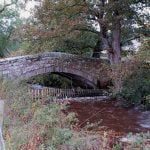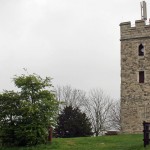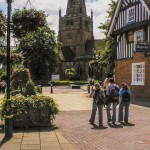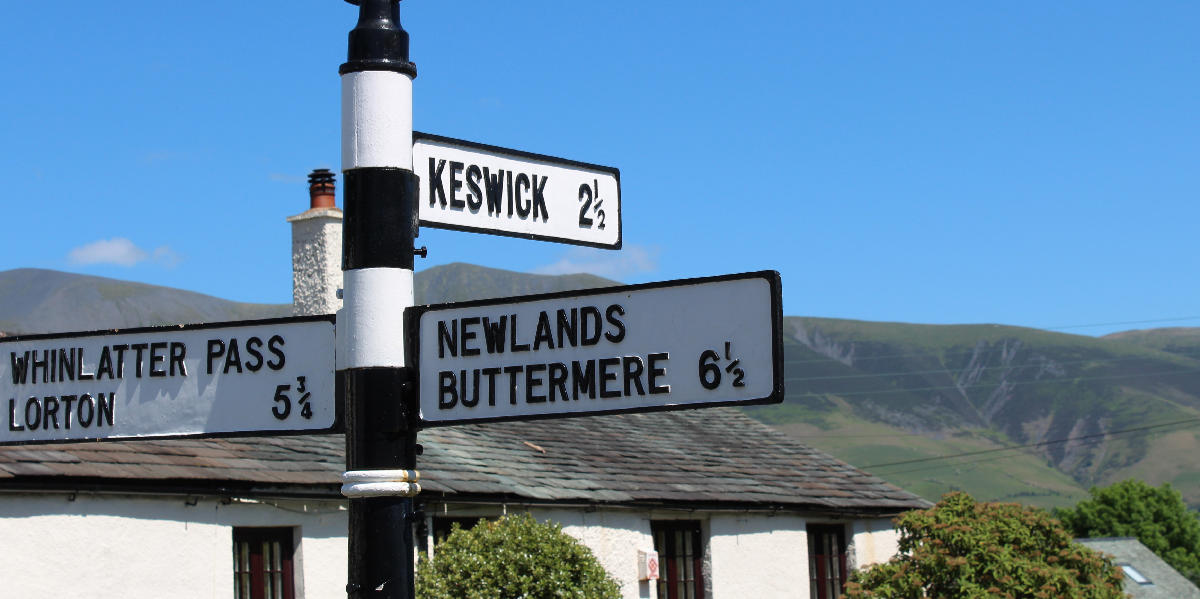
Go to the Cumbria Business Directory
Keswick is the biggest market town in the Lake District and despite lying more towards the north of the National Park it is an ideal Cumbrian staycation base. Often dubbed the Capital of the Lakes, the good news is that it retains its historic character and is handy for both the Skiddaw Mountains and Derwentwater.
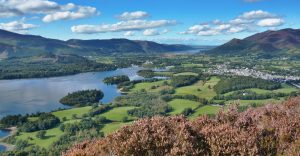
Image: Philip Birtwistle/ Shutterstock.com
Anyway, whether you want to explore the great outdoors, indulge in some fine dining or just chill out in some stunning scenery Keswick is a great choice. After all its no often you can say you holidayed in the shadow of both of Englands Highest Mountains.
Where Is Keswick
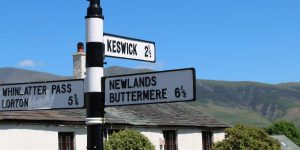
Image: John Cartwright/Shutterstock.com
It’s towards the northern end of the Lake District National Park in Cumbria right next to Derwent Water. It is in the CA12 postcode district and if you are driving we would suggest putting CA12 5DG into your satnav, as this will take you directly to the towns main car park! So now you know where it is how about a little local history to further pique your interest?
A Little Keswick History Lesson
The topography of Keswick and the North Lakes was formed in the Ice Age when glacial erosion shaped the landscape of mountains, valleys and lakes. Evidence of first settlement dates as far back as the Stone Age and Neolithic man. Three axes found at the Castlerigg Stone Circle thought to be more than 4000 years old, provided particular strong evidence of the earliest farming communities in the area.
In the Dark Ages and the early medieval period, Keswick along with much of north Cumbria was part of the Kingdom of Strathclyde. However, the town’s and surrounding village names, reflect the known 10th century Viking occupation. The Norse traders and farmers are credit with introducing the hardy Herdwick sheep to the area. Today, the Herdwick breed is prolific throughout the region and can be found on many of the county’s hill farms. Poignantly, the sheep were instrumental in giving Keswick its name, as it literally translates to ‘cheese town’.
Cistercian monks arriving in Furness in the mid-13th century acquired large swathes of Cumbrian land. Thus, they went on to take control of sheep farming and the wool industry in the area. The development of Keswick’s community continued with the granting of a market charter by Edward I in 1276.
The Rise of Mining
By the mid-16th century, mining had become economically important to the Keswick area. Slate mined from Skiddaw was utilised for roofing and floors, while mining of copper also began in the Newlands and Borrowdale Valleys. However, by far the most important locally mined material was graphite or ‘black lead’ as it was otherwise known. In 1555, the first lease to mine graphite in the district was issued. It was initially used for writing and artistic purposes, but soon after it became far more important when the military found uses for it. In 1566, Queen Elizabeth I personally gave the instruction for mining in the Keswick area to be stepped up, as England was desperately short of cannons and weaponry. The Society of Royal Mines was established to finance and oversee mining operations. In contrast to the booming and lucrative mining industry the remainder of the local economy was based on wool, crops and leather undertaken by rural poor.
Let’s Make a Pencil
In 1683, the world’s first lead (graphite) pencils was reportedly made in the Keswick. By 1800, the price of good quality graphite had risen to more than £3500 per ton, which was well over 200 times the value of lead. This made graphite a target for thieves and smugglers, particularly since it was banned for export by the government. By this time, the manufacture of pencils had flourished in the area in the form of a cottage industry. By the late 19th century, there were several pencil factories in the town. Keswick remained at the centre of British pencil-manufacture until very recent times.
And Then The Fall
After a century or so, the Newlands and Borrowdale copper mines went into decline as the economics of their operation became unviable. It was in the 18th and early 19th century that Keswick’s mines had been at their most productive, but the ending of this era did not spell the end of mining in the area. Force Crag Mine, near Braithwaite, was still in operation up until recent times producing a range of materials. Threlkeld Quarry brought a century of employment to the area. Quarrying for slate was first recorded at Honister in 1643, but the mine remained in operation for almost 350 years, employing around 100 men at its peak.
The Gentry Discovers The Lakes
The Lake District was first discovered by well-heeled visitors in the 1750’s which led to Keswick quickly becoming the main centre for the new tourism industry. By the 1770s, tourism was further facilitated by the great improvement in roads. At the end of the 18th and beginning of the 19th century, some of the country’s most celebrated poets and artists began to congregate in Keswick on a regular basis. Wordsworth, Coleridge and Shelley, amongst others, all lived or spent significant amounts of time in the Keswick area during this era. They were instrumental in popularising the region, which was opened up to wider tourism by the arrival of the Cockermouth, Keswick & Penrith Railway railway in 1865. The town’s population, grew from 1,350 in 1801 to 2,618 by 1851.
In the same era, Keswick’s industrial base also expanded; while leather production had begun to decline, other manufacturers such as the woollen textile industry began to grow steadily. Pencil manufacture expanded notably from the late 18th century, becoming the town’s largest industry with the founding of Joseph Banks’ pencil factory at Greta Mill in 1835. The population of the town had grown to 3,760 by 1891, as its boundaries expanded north of the River Greta and to the east of old urban core.
20th Century Keswick
In 1903, an unknown writer named Beatrix Potter holidayed in Keswick for the first time, beginning her long love affair and association with the region.
Across 20th century tourism came to dominate, and by the 1930’s, Keswick was firmly established as the main centre of tourism in Cumberland. The town’s industrial base continued to steadily decline. The Briery Cottages Woollen Mill closed in 1900; with the site’s bobbin mill eventually following suit in 1958. Pencil manufacturing became the second-largest source of employment but takeovers and mergers reduced the number of factories operating in the town. In contrast to much of the rest of the UK, the town’s population remained relatively stable across 20th century, standing at only 4,984 in 2001.
Keswick – The Modern Era
Even within the Lake District itself, Keswick is particularly renowned for its scenic landscapes. It was described by Wordsworth as “the loveliest spot that ever man has found’’. The creation of the Lake District National Park in 1951, with strict control over new development, has prevented the expansion of Keswick beyond its pre-war borders, and thus, its striking backdrop has also been maintained. Consequently, since the 1950’s, the town’s population has remained stable at a little below 5,000 residents.
The uniqueness of Keswick has perhaps helped to shape what could be considered as a negative facet of its identity, in as much as, the age profile of its residents is significantly higher than the average for England. While there are around a third less children under 10 than the national average, there are almost double the number of residents within the 75 – to 84-year-old bracket. However, on the plus side, figures from the same census also show that Keswick has higher than average number of small employers and self-employed people. Long-term unemployment in Keswick is considerably below the UK average.
21st Century Keswick
In the 2001 census, more than 60 per cent of the town’s population were found to be employed in either hotels, restaurants or retail. In 2008, the town became even more reliant on tourism when the Cumberland Pencils operation moved production from Keswick to Workington. However, the Cumberland Pencil Museum was retained on the original site and features as one of the main tourist attractions in the town. With it’s many attractions and great opportunity to pursue a variety of sport and leisure activities, there are plenty of things to do in Keswick. Consequently, the town’s population is greatly inflated by walkers, sightseers, sportsmen, climbers, etc. who congregate there at all year round.
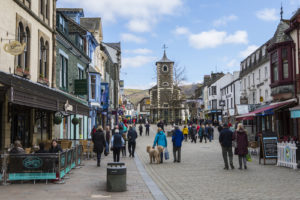
Keswick Town Centre Image: chrisdorney/Shutterstock.com
Getting there!
If your travelling to Keswick by road then it is probably most easily reached via Junction 40 of the M6 (Penrith). Then head westwards along the A66. If your travelling from the east, go via the A1 and then the A66. If your heading from the South, then a more scenic route would be to leave the M6 at junction 36 and take the A591 through Windermere, Ambleside and Grasmere. The average journey time from London would be around 6 hours. The nearest railway station to Keswick is Penrith on the West Coast Main Line, which is a distance of 17 miles. A bus service, taking forty minutes, connects Penrith railway station with Keswick Bus Station.
Keswick is roughly equidistant from the two nearest international airports, which are Manchester and Newcastle. A local domestic airport is due to open on the outskirts of Carlisle in 2019, serving Belfast, Dublin and London (Southend).
Go to the Keswick Business DirectoryPlaces to see in Keswick
There are lots of places to see in and around Keswick, a few suggestions are the following:
The Lakes Distillery
The Lakes Distillery is the largest whisky distillery in England and is set in an area next to Bassenthwaite Lake, which is overlooked by one of the Lake District’s highest peaks, Skiddaw. The distillery runs an interactive tour to suit all ages which tell the story of how its premium whisky, gin and vodka products are made and include a tasting session at the end.
Derwent Pencil Museum
Only a short walk from the town centre, Derwent Pencil Museum is the home of the first pencil, and the Cumberland Pencil Company, manufacturers of Derwent pencils since 1832. You enter the museum through a replica of the Seathwaite mine where graphite was first discovered in the 1550’s. Through words, pictures and carefully restored machinery you can trace the history of pencil making. Through, art workshops, demonstrations, quizzes, etc. it is very much an interactive experience, and specially formulated very much with children in mind.
Castlerigg Stone Circle
Castlerigg Stone Circle is among the earliest of British circles, thought to have been constructed around 3000 BC during the Neolithic period. The original purpose of the Stone Circle remains but historians have mused that it could have been used as a trading post, meeting place for social gatherings, an astronomical observatory or as a site of religious ceremonies. The site of the circle has perhaps the most dramatic setting of all the British stone circles, being completed with panoramic views of the close by mountains of Helvellyn and High Seat. Parking is limited but you can walk to the site from the centre of town in about 30 minutes.
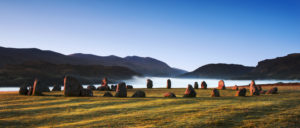
Castlerigg Stone Circle Image: Nigel Eve/Shutterstock.com
Things to do in Keswick
There are lots of things to do in and around Keswick, a few suggestions are the following:
Theatre by the Lake
Just a five-minute walk from the town centre, Theatre by the Lake, is situated on the shores of Derwent Water in a setting that is the envy of the arts world. Annually, it stages a good number of its own productions of classic, modern and new plays, which have received national critical acclaim. Additionally, it also hosts regular literature, jazz, and film festivals. The theatre provides food and beverage as well as good disabled access.
Whinlatter Forest Visitor Centre
England’s only true mountain forest, Whinlatter Forest is managed by the Forestry Commission and is a great day out for all ages. There are a number of walking and mountain bike trails of varying degrees of difficulty at the site. There are also a variety of children’s play areas with climbing walls, water features, giant swings, secret paths, etc. And, if you’ve got a head for heights, you can swing through the trees on the Go-Ape treetop course. The Visitor Centre is home to the Lake District Osprey Project from April to August each year, which features an exhibition about the project. There’s a cafe at the visitor’s centre and an onsite bike shop, that both sells and hires out bikes, as well as offering bike skill training courses. The Visitor Centre and main car park is just west of Keswick and is signed from the A66.
Derwentwater Marina
At the marina, you can hire canoes, kayaks, stand up paddleboards, rowing boats, dinghies or windsurfers for exploring the lake. Tuition is also available for sailing, windsurfing, canoeing, kayaking, ghyll scrambling and paddleboarding, for both individuals or groups. The marina is situated at the north end of Derwentwater, being just 5 minutes by road or a 15 minute walk away from Keswick.
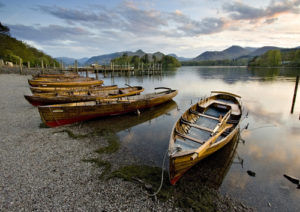
Derwentwater, Keswick
Places to Stay in Keswick
Being at the heart of the Lake District, there is a great variety of accommodation available in and around Keswick. A rough guide to costs for the most readily available types of accommodation in and around the town are:
Guesthouse/B & B/Lodge £50 – £70
Hotel: £70 – £150
Holiday Home/Apartment: £60 – £80 pp/pp for maximum occupancy
The Keswick Quiz
So you think you know Keswick?
Archaeological evidence suggests Keswick was first settled when?
Keswick literally translates from Old Norse as what?
At the turn of the 19th century Keswick was one of the very few places in the world where graphite (aka black lead) was being mined. Approximately how much was graphite worth per ton in 1800?
What year was Keswick Railway Station opened?
What was the population of Keswick at the 2011 census?
What metal was being mined in the Newlands and Borrowdale vallleys during the 17th century?
Which famous children’s author began holidaying in Keswick in 1903?
Which poet is known for his quote on Keswick, as “the loveliest spot that ever man has found’’?
keswick was world renowned for the manufacture of pencils, an in industry associated with the town for some 500 years. In what year did production of pencils finally cease in the town?
Which of the following is NOT a ‘pass’ on the road network in the general Keswick area?
Average!
No worries – that’s average!
Very good!
Smarter than the average cookie!
Brilliant!
Mastermind awaits!
Quiz Maker – powered by Riddle
